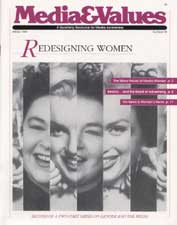How to Evaluate Media Images of Women
|
This article originally appeared in Issue# 49
|
At the beginning of my career in the 1970s I spent time actively looking in television and film for characters who would reflect my goals and help me see what was possible for a woman in this society.
At that time I could only find two images I could identify with on any level. Emma Peel, the cool crimefighter on The Avengers impressed me with her independence and savoir faire, while Mary Tyler Moore's Mary Richards was struggling with many of the same personal and professional issues I was myself.
Otherwise, the many women featured in movies and TV programs were usually flat, shadowy figures, someone's wife or girlfriend. Or they were stock figures of fun: the mother-in-law, the kid sister, the old maid.
Nearly two decades later, women's images are somewhat less limited. From Murphy Brown to Roseanne, women are expected to earn a paycheck, if not launch a career. Working mothers abound. Even the wealthy beauties of Dallas focus on greed as much as glamor.
Women have yet to be all they can be onscreen, however. Stereotypes are shaded more subtly, but they are still there. Female leads must still be brighter, smarter and funnier than their male counterparts (and, almost always, much better looking as well.) Wrinkles and glasses are still taboo. More depressing still, too many parts still feature "the wife," "the mother" or "the girlfriend" as interchangeable parts.
If images of women were only limiting, if would be sad, but not tragic. Unfortunately, most of the images of women are not just restricted, but negative. These images misrepresent who we are, demean us, and make it harder to see women as people. When women are only shown as beautiful and passive or rich and bitchy, it becomes more difficult for both men and women to accept them as the diverse, multifaceted people they really are.
The stories and images we carry in our heads can mold us as profoundly as other major influences such as our families, educational experiences or religious beliefs. If they are inadequate or negative, that's bad news. The good news is that it's possible to break out of stereotyping.
What We Want
Entertainment media owe us more than the dizzy blonde, the uptight spinster, the sweet madonna and the demanding executive. We applaud images of women who require a whole realm of adjectives to describe them, women who, like Chris and Mary Beth of Cagney & Lacey, who are strong, sometimes brassy, sometimes sensual, often compassionate, usually making good decisions but not always, emotionally responsive, at times angry and always interesting.
These women are satisfying, because their diversity makes them seem real. We are not looking just for heroines, but for allowing women to be complex and many-sided as people of either sex can possibly be. Looking for ways to portray the opposites that are contained within any one person can help create real portrayals. It's also the best way to avoid stereotypes.



